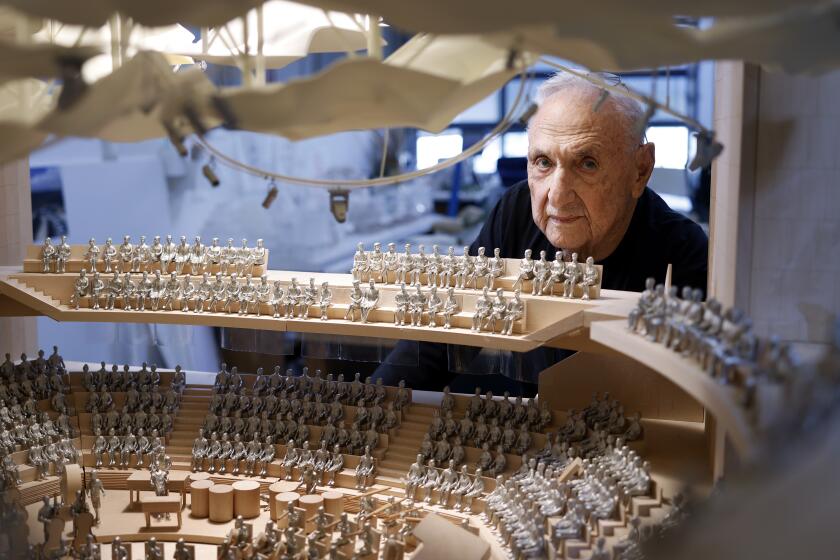Downtown L.A. is hurting. Frank Gehry thinks arts can lead a revival
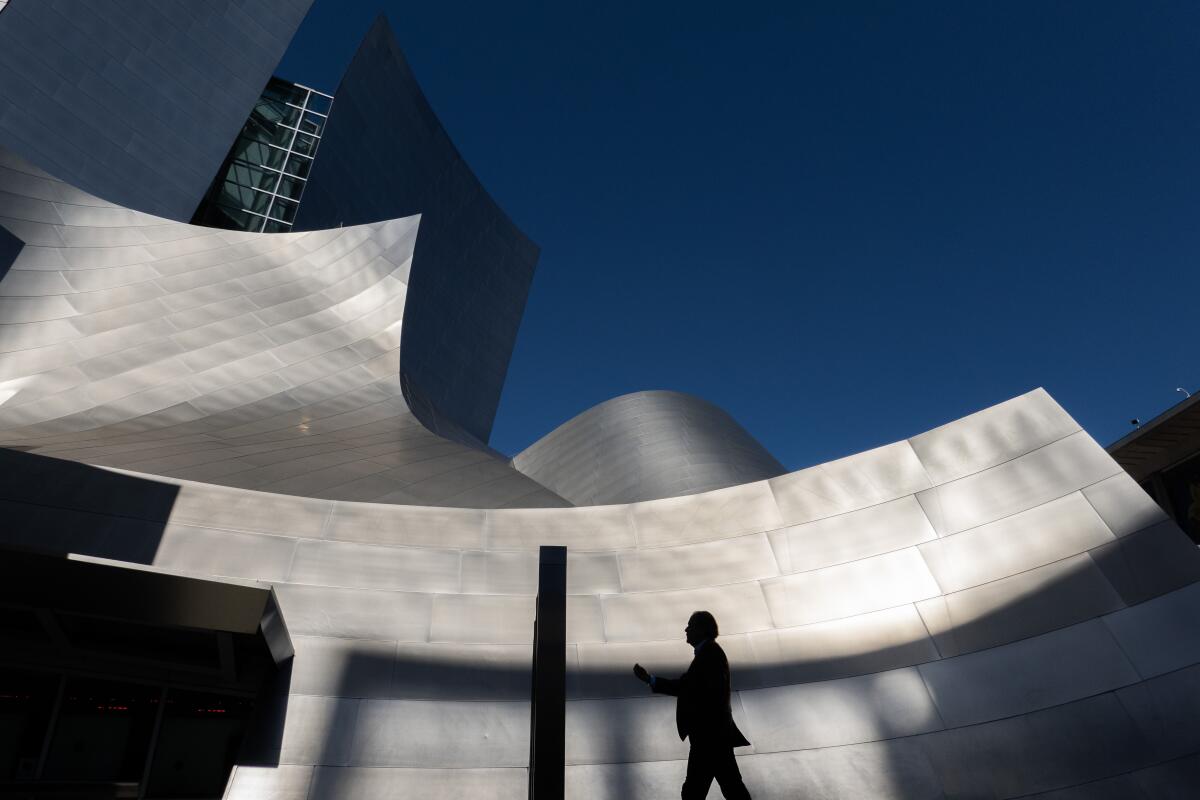
With two major expansions of downtown Los Angeles cultural institutions in the works, Bunker Hill is primed to elevate its status as the region’s leading arts center even as the area around it struggles with persistent homelessness and post-pandemic losses of office tenants.
Bunker Hill will soon have the largest concentration of buildings designed by Frank Gehry in the world and promises to become a cultural center “like no other place,” the architect told the Los Angeles Times.
The Broad recently announced a $100-million project that will increase gallery space at one of the city’s most popular museums by 70%, and the Colburn School for performing arts just broke ground on a $335-million expansion that will include a midsize concert hall — designed by Gehry — that is expected to be in near-constant use for events put on by students, professional artists and academics.
Gehry has been a key player in the decades-long comeback of Bunker Hill, a former residential neighborhood that is now home to cultural institutions, office skyscrapers, apartment towers and hotels. With the coming additions, Gehry said, Bunker Hill stands to surpass the vision he, museum founder Eli Broad and other civic leaders had in the 1990s when work got underway on Walt Disney Concert Hall as part of the government-led Grand Avenue Project to revitalize the neighborhood.
Planners at the time hoped to build on the appeal of the Music Center, which was built in the 1960s and served as a popular destination for arts patrons who typically drove in and out without stepping outside its boundaries.
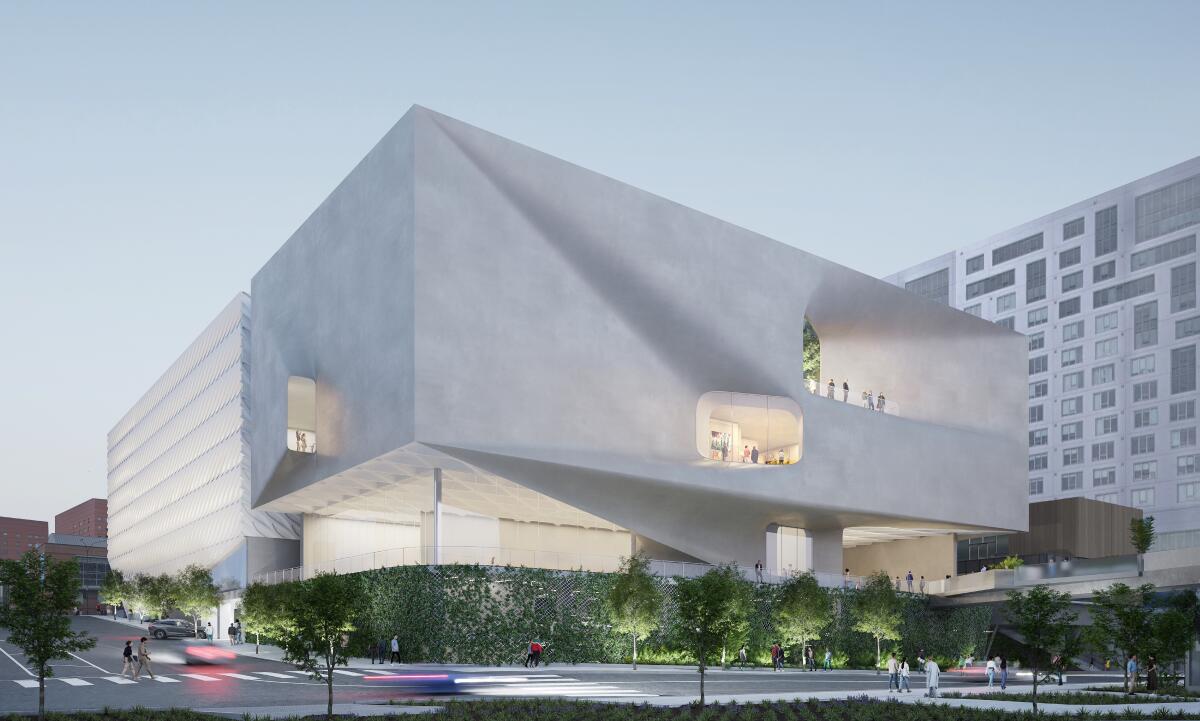
“We have come a long way since the Dorothy Chandler Pavilion and the other Music Center venues opened,” Gehry said. “So much great energy has come to the fore.”
Bunker Hill is still unlikely to feel similar to cultural centers in other big cities, he acknowledged, and laughed off a reminder that Broad had suggested Grand Avenue could become L.A.’s version of Paris’ Champs-Elysees.
“Los Angeles cannot be compared to anywhere else in the world. It’s different than other cities,” Gehry said.
Bunker Hill is slightly removed from the homelessness and safety concerns that trouble the financial district just south of it, said John Sischo, who has worked in the real estate business downtown since the 1980s.
“Homelessness is a big problem that keeps office tenants from coming downtown,” he said. Safety issues are both “real and perceived.”
In the two decades before the COVID-19 pandemic, civic leaders and landlords pushed to elevate the financial district that Sischo recalled as a “doughnut hole” between Bunker Hill — with its highbrow cultural scene — and the booming new neighborhood of South Park near Crypto.com Arena and L.A. Live, where sports and entertainment ruled.
Thousands of apartments and condominiums were added to the financial district — followed by bars, restaurants and stores that thrived on the residents and office workers whose bosses took advantage of comparatively low rents in gleaming towers that were being upgraded by their owners.
The drop in street life from workers staying at home during the pandemic and continuing to work remotely has been a drain on the vibrancy and sense of security in the financial district, which is depressing office leasing and hampering the neighborhood’s comeback, Sischo said.
Falling office values have led to foreclosures on some prominent office towers, including 444 S. Flower St., which was owned by Sischo’s company, Coretrust Capital Partners.
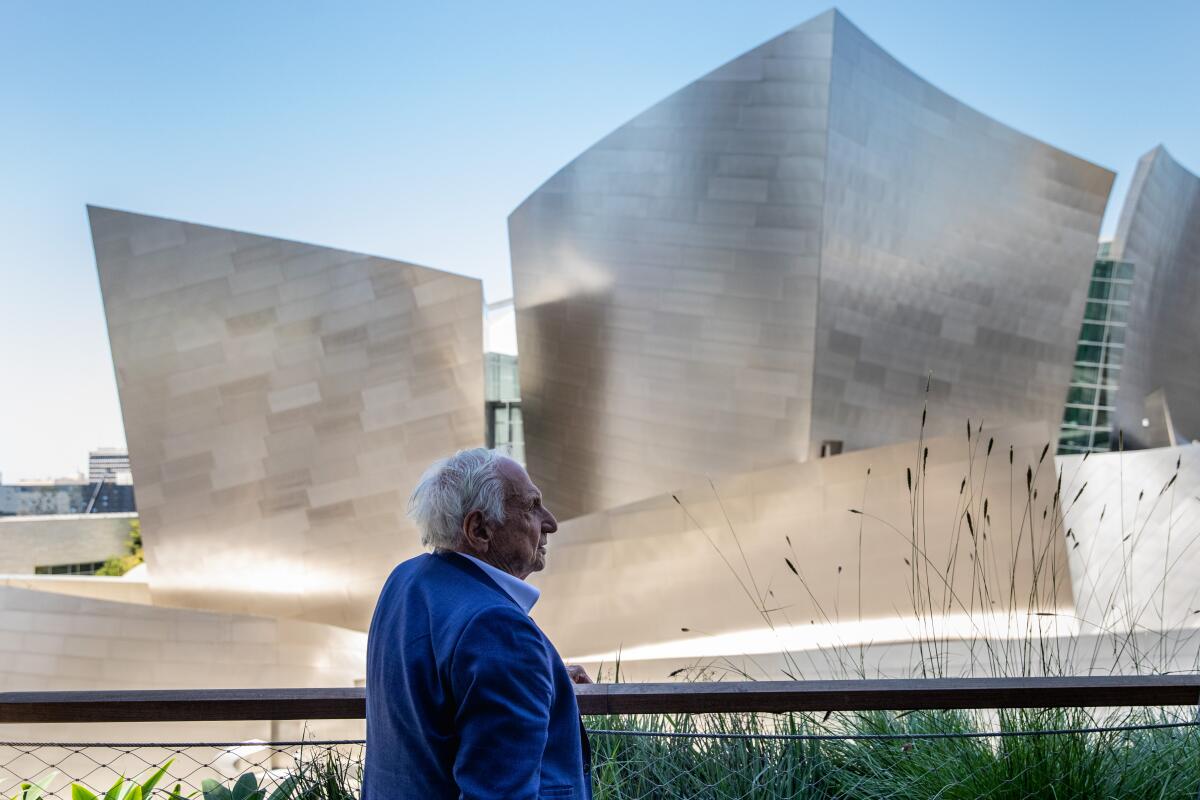
“Pre-COVID, it was really jelling,” he said of the financial district.
The most transformative addition to Bunker Hill in recent years was the Grand, a $1-billion hotel, apartment and retail complex designed by Gehry that stands across Grand Avenue from Walt Disney Concert Hall, which he also designed.
“Now Disney has context,” Gehry said in 2022 on a balcony at the Grand overlooking the home of the Los Angeles Philharmonic. “For me, it all fits now. Disney Hall doesn’t look like an outlier.”
In the nearly two years since the Grand opened, its 45-story apartment tower has been nearly fully leased, owner Related Cos. said.
The Conrad Los Angeles hotel there is “outperforming the market,” said Nicholas Vanderboom, chief operating officer of Related California, in part by “catering to growing interest in L.A’.s arts institutions.”
Spanish chef José Andrés operates restaurants at the Grand and more places to eat are coming in a part of the complex that has been dark since it opened, to the dismay of neighbors who have been waiting for long-promised retail venues on Grand Avenue. One of the features Gehry designed was space for stores and restaurants on the avenue and on terraces above that overlook the Disney Concert Hall, but it’s still mostly unoccupied.
Later this year, Andrés will open a Bazaar Meat, his high-end steakhouse that originated in Las Vegas, on the second level. Santa Monica Italian, French and Moroccan restaurant Massilia will also open a branch on Grand Avenue this year, and other tenants will be announced in 2024, Related said.
The additions to the Broad and the Colburn promise to boost foot traffic on Grand Avenue, said Sel Kardan, president of the Colburn School, which opened on Bunker Hill in 1998 and has about 2,000 students.

Construction began recently on the expansion of the Colburn School. It is the third Gehry-designed building on Bunker Hill.
Colburn Center, as the addition will be called, will include a 1,000-seat concert hall with an in-the-round design meant to create intimacy between the performers and the audience. The hall will have an orchestra pit and a stage large enough to accommodate “the grandest works,” Kardan said, making it suitable for orchestra, opera and dance.
Work has begun on a new concert hall designed by architect Frank Gehry at the Colburn School of performing arts in downtown L.A. The project will be the third Gehry-designed building on three contiguous blocks of Bunker Hill.
He expects that the new hall will host more than 200 events a year at various times of day. The Colburn Center will also more than double facilities for the school’s Trudl Zipper Dance Institute, creating what the school called “one of the most comprehensive dance education complexes in Southern California.” The facilities will include a 100-seat theater and four professional-size studios for instruction and rehearsal.
With the new addition, “there could be three or four performances going on on our campus on any given night,” Kardan said, a combination of educational performances, guest artists and events put on by local arts organizations.
The Colburn Center is set for completion in 2027. The Broad expansion should open a year later, museum President Joanne Heyler said, and add to street life on Grand Avenue.
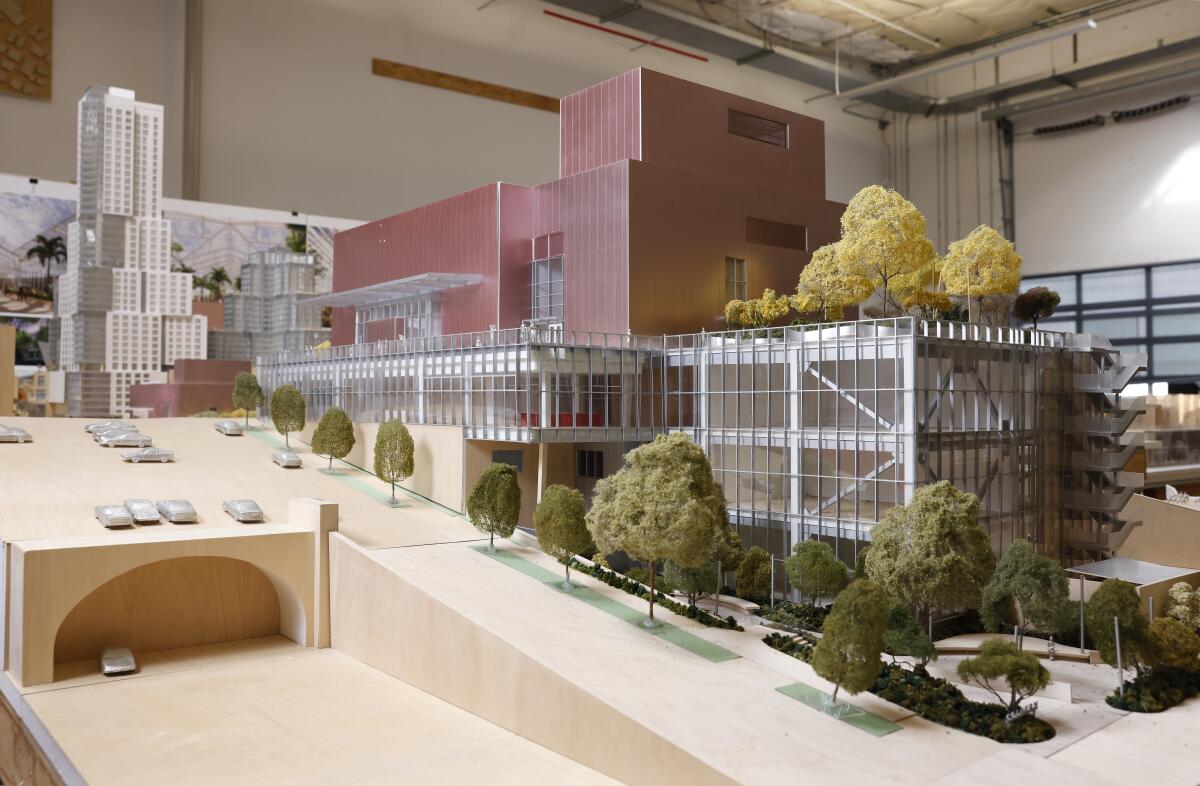
Attendance at the Broad has returned to pre-pandemic highs of more than 900,000 annual visitors, she said, with a new daily record of more than 6,000 visitors set in March.
With the expansion,”we’re simply responding to the tremendous enthusiasm of our audience that is now consistent with pre-pandemic levels and seemingly growing,” she said.
“I am under no illusion that downtown in general is free of challenges,” Heyler said. “We in the entire area have a lot to work on, but as a meeting point, a place to enjoy a cultural destination, our experience with the Broad is that things are vibrant. And I know that goes against the typical narrative of downtown.”
The Grand was “the next-to-the-last piece of the puzzle” for Bunker Hill, said landlord Christopher Rising, whose firm Rising Realty Partners owns two office buildings there. The final piece will be Angels Landing, he said, a $1.6-billion hotel-housing-retail complex set to rise next to Bunker Hill’s historic Angels Flight railway in time for the 2028 Olympics.
Rising laments that office attendance is still below pre-pandemic levels, especially among nearby government buildings that were packed with public employees who helped bring a sense of activity to Grand Avenue and other downtown streets.
“There are years of vision that are coming to fruition” on Bunker Hill, Rising said, “but the vision was heavily dependent on synergies with government workers. Without them, it’s slowing things down.”
More can be done to improve Bunker Hill, Gehry said, and the streets near Grand Avenue that are thick with parking lots are now ripe for development. The Colburn addition is going up next to the existing school on a former asphalt lot at 2nd and Olive streets.
“To keep upping the ante, we still have work to do,” Gehry said, such as “fixing” the Chandler Pavilion to make it a better venue for opera performances.
“There are also opportunities to connect down to the arts district, the civic center, and Little Tokyo on the east-west streets,” he said. “That is very exciting to me.”
More to Read
Inside the business of entertainment
The Wide Shot brings you news, analysis and insights on everything from streaming wars to production — and what it all means for the future.
You may occasionally receive promotional content from the Los Angeles Times.
